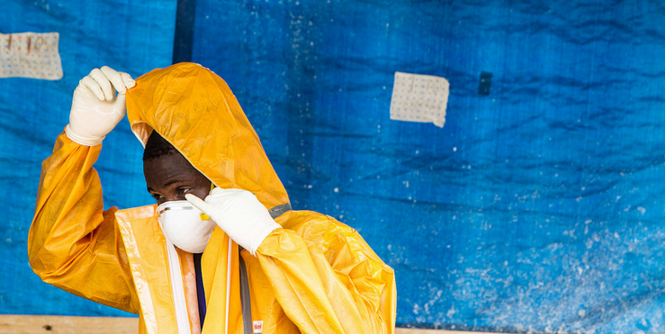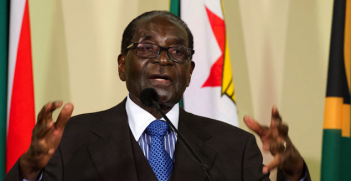Ebola 2013-2015 – How Long Will the Memory Last?

In December 2013 a small boy in a remote Guinean village and three of his family members died from a mysterious disease. By the time the World Health Organisation (WHO) was notified of an outbreak in March 2014, it had spread to neighbouring towns and the capital, Conakry. It was identified as Ebola a week later.
By then about 90 people had been infected, two thirds fatally, and cases had been identified in neighbouring Liberia and Sierra Leone. Already the outbreak was unique: all 25 previous outbreaks (since 1976 when Ebola was first identified) had been in central Africa and limited to a single village or small town. Local government officials initially downplayed the extent of the outbreak, however by June Médicins sans Frontière (MSF) – one of few organisations working to contain it – described it as “out of control”.
The rest of the world took little notice until early August, when two American aid workers were infected with Ebola and evacuated to the US for treatment. On 8 August, WHO belatedly declared “a public health emergency of international concern” but there was little immediate action. In September, an increasingly frustrated MSF President, addressing the UN General Assembly, criticised the “global coalition of inaction” and made an unprecedented plea for ’massive deployment of military and civilian teams… to contain the biological disaster’.
Within days the US President promised 3000 military personnel to provide medical and logistical support and the UN established its Mission for Ebola Emergency Response – the first for a health emergency. Over the next four months, international resources were slowly mobilised but the disease continued to spread; by year’s end there had been around 20,000 cases and 8000 deaths. Then the numbers at last plateaued and began to fall as more treatment centres and laboratories were commissioned and contact tracing and safe burial teams deployed.
Meanwhile, the rest of the world began to fear for its own safety. In October, a Liberian-American man was admitted to hospital in Dallas, Texas with initially unsuspected Ebola. After two nurses who had cared for him were infected, there were acrimonious accusations and over-reactions in the USA and elsewhere. Some countries banned – or threatened to ban – flights from West Africa despite likely adverse effects on control efforts. Additionally, several US states (and one Australian state) inappropriately mandated home quarantine of aid workers returning from Ebola-affected countries, despite warnings that it would jeopardise recruit of volunteers. Australia also temporarily blocked refugees from West Africa.
The Dallas incident also undermined reassurances from the Centers for Disease Control (CDC) that strictly applied “routine” infection control measures would prevent hospital transmission of Ebola, which occurs from direct contact with body fluids of severely ill people. CDC was not wrong, but “routine” hospital infection control measures are often not properly applied. Moreover, the diagnosis had been missed when the patient was first seen early in his illness, when transmission would have been unlikely.
Infections of nurses in the US and the terrible toll among healthcare workers in West Africa focussed the attention of hospital administrators and frontline staff around the world. Alarming deficiencies were identified, in knowledge and standards of routine infection control practice, which is often given a low priority.
In Australia – and presumably in most developed countries – preparations to receive patients with Ebola were unco-ordinated and inconsistent between jurisdictions and hospitals. Fear that the Ebola virus had become more transmissible or virulent prompted recommendations for extra personal protective equipment which were impractical, potentially dangerous and confusing. By the time nationally consistent Ebola prevention and control guidelines were published the risk had almost passed. There were no Ebola cases in Australia and only a small number (around 30) anywhere outside of Africa.
On 7 November 2015, Sierra Leone was declared Ebola-free and there have been no confirmed cases in Guinea since 29 October but strict surveillance continues. Liberia was declared Ebola-free in May 2015 but two small clusters, assumed to have arisen from rare re-emergence of the virus in survivors, have occurred since. To date (13 December) there have been 28,604 confirmed, probable and suspected cases and 11,300 deaths in the three most affected countries – thankfully far fewer than the possible 550,000-1.4 million predicted in September 2014, but over 60 times more than any previous outbreak. The international ramifications have been immense.
The WHO has been severely criticised for a delayed, ineffective response. But its ability to respond to infectious disease emergencies is strictly limited, especially since a recent 51 percent budget cut. Local governments initially downplayed the seriousness of the situation, implying that assistance was not needed. The WHO was also understandably cautious about raising the alarm after criticism that it over-reacted to the H1N1 influenza pandemic.
Nevertheless, WHO Director-General Dr Margaret Chan has acknowledged the shortcomings of the organisation’s response and promised reforms to improve emergency response capacity, although clearly this will depend on funding from member states. There is a need to strengthen International Health Regulations, which require that member states acquire the capacity to identify and report infectious diseases of international concern and seek assistance to control them if required. Considering their grossly inadequate healthcare and disease surveillance systems, Guinea, Liberia and Sierra Leone had neither the capacity nor apparently the will – at least initially – to comply.
The international community must also carry responsibility for a slow and initially inadequate response. Many countries, including Australia, offered funds but not people, who were desperately needed to build facilities and train local health workers. Many countries spent a fortune on their own hospital preparations, for what should be routine practice – effective infection prevention and control. We cannot predict when, or in what form, future infectious disease emergencies will occur but that they will is inevitable. Next time we are unlikely to have the luxury of months of preparation time.
If we are to avoid another devastating international or local epidemic comparable to the 2013-2015 Ebola outbreak we must be better prepared and respond more quickly and effectively.
Lyn Gilbert is a Conjoint Professor of Medicine and Infectious Diseases at the Marie Bashir Institute for Emerging Infections and Biosecurity, University of Sydney. This article can be republished under a Creative Commons License.





